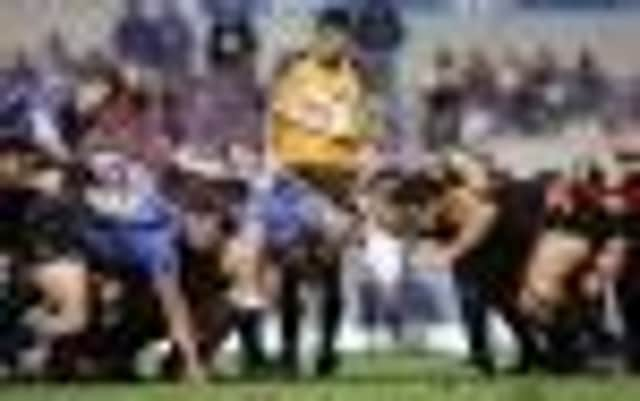Allan Massie: Straight put-in could rekindle lost art of contested scrum


As my older correspondents remark, referees used to penalise squint put-ins in their day, and no longer do so. Yet it’s not as if the law has been changed. The requirement is still there.
There is one simple explanation. Scrums nowadays collapse and have to be reset so frequently that referees are only too happy to permit the ball to be put in squint if only in the hope that it will emerge quickly and allow the game to proceed. This explanation is quite persuasive, at least until you reflect that referees are quick to whistle up other scrum infringements, most of which are invisible to the unofficial eye. So if they are severe on props whose arms are in the wrong position and who are not binding properly, if they immediately award a free kick against a scrum which anticipates the call to engage, why do they continue resolutely to ignore squint put-ins?
Advertisement
Hide AdAdvertisement
Hide AdOne other explanation has sometimes occurred to me: that they are so busy watching what the props are doing that they take their eye off the ball. There is some evidence to support this theory. Referees used to crouch opposite the scrum tunnel, and were therefore alert to the possibility of a squint put-in or a hooker striking early (“foot up”). Now they usually stand upright, looking down on the scrum. So they can’t, or don’t, watch the put-in.
Yet, even if this is now the common practice, it is also the case that referees, in the upper levels of the game, are now wired up to, and in communication with, their touch judges (or assistant referees) who are in a position to advise them that the ball hasn’t been put in straight. Such advice never seems to be forthcoming, or, if it is offered, is disregarded.
The consequences of this general refusal to apply the law are numerous. Brian Moore, who knows a thing or two about front-row play, recently observed that the No 2 forward should no longer be described as a “hooker”, because the one thing he no longer does is hook.
His job is to push, not to strike. If his scrum-half is inserting the ball, it will enter the scrum under, or even behind, his feet. His job is to walk over it. If it is unnecessary for him to strike, it is pointless for his opposite number to do so, because he has no chance of getting his foot near the ball.
So the props are no longer required to support and assist their hooker as he strikes. Instead they are there simply to push and disrupt the opposing front row. If you doubt this, look at the position of their feet. A prop used to have his outer foot ahead of his inner one. Now a prop’s feet are usually level with each other, to enable him to push harder.
Now if you think that the purpose of the scrum is merely to restart the game (as it is in Rugby League), you may believe that none of this matters. But it does, because the Union game is different from the League one. In League the scrum is in effect uncontested. The ball goes in and comes out quickly. In Union the contest is still fierce but, with the hooker not striking, one almost never sees quick, clean, well-channelled ball. It is now more usual to see the ball being first handled by the No 8, not the scrum-half. The No 8 pick-up used to be an occasional surprise tactic. It is now the standard procedure. The No 8 picks up and drives forward, usually on a diagonal. He is then tackled and a ruck follows. Even if the ball then emerges quickly, as indeed it often does, the defence has by now spread across the field. So there will be another forward drive and then another, and another, and so on.
Some years ago, the offside law in relation to the set scrum was amended to require all players (except the scrum-half) who are not participating in the scrum to be five metres behind the hindmost foot, while back-row forwards were required to remain bound until the ball was out of the scrum. The intention was, obviously, to give the fly-half and centres time and space, and so to encourage them to move the ball and play a wide game.
The intention has very evidently not been fulfilled. The law was good in theory. Practice has made a nonsense of it. Since the ball is so rarely in the scrum-half’s hands straight from the set scrum, it even more rarely reaches the fly-half.
Advertisement
Hide AdAdvertisement
Hide AdYet the remedy is clear. First, apply the law which requires the ball to be put in straight, so that the side not putting the ball in has a chance of securing possession.
Yet this might not be enough in itself, so ingrained have habits become; we might still have both scrums engaging in an eight-man shove. There is perhaps a way to avoid this. All that is needed is a simple amendment of the law: to make it an offence for the hooker not to strike.
There would probably be two consequences. First, we might again see quick, clean ball emerging from the scrum – and occasionally heels against the head too. Second, with props once again having to concentrate on supporting and assisting their hooker, we would see fewer scrums collapsing and having to be reset.
But will this happen? Seen any flying pigs recently?